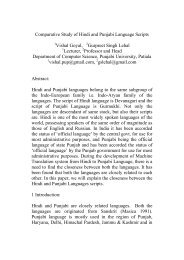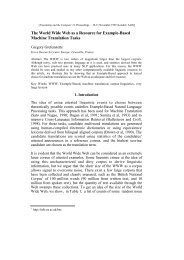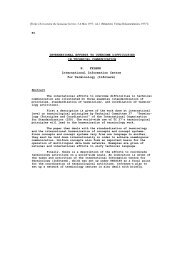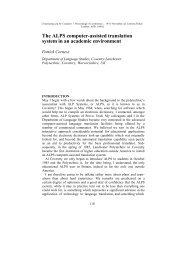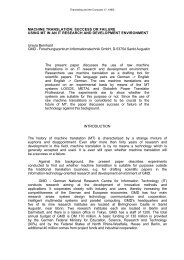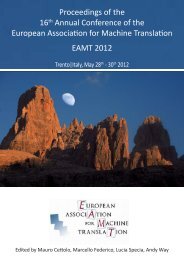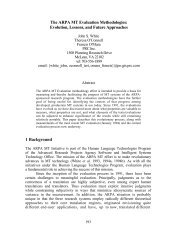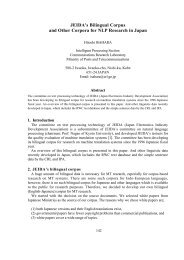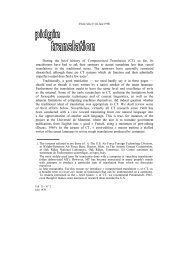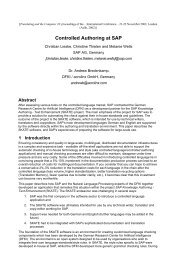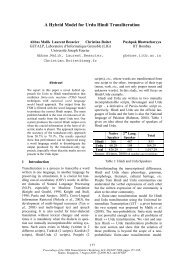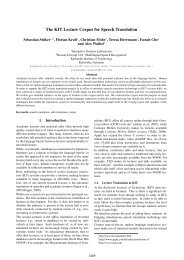Georgetown Automatic Translation: general information and ...
Georgetown Automatic Translation: general information and ...
Georgetown Automatic Translation: general information and ...
Create successful ePaper yourself
Turn your PDF publications into a flip-book with our unique Google optimized e-Paper software.
the nature of the suffixes <strong>and</strong> other morphological factors in the text word,<br />
This program has about 4,000 computer instructions <strong>and</strong> can be run on a 709,<br />
7090, or 7094 computer. The input, output, <strong>and</strong> internal processing oper-<br />
ations are "buffered" <strong>and</strong> overlapped such that maximum speed is maintained<br />
in the running of the program.<br />
The split glossary is read into three areas, Al, A2, <strong>and</strong> A3, in the<br />
memory - - each area can take 150 items or 5,100 machine words. The un-<br />
split glossary is read into two areas, Bl <strong>and</strong> B2, in the memory - - each<br />
area can take 68 items or 2,992 machine words. The input text is read into<br />
two areas, Cl <strong>and</strong> C2, in the memory - - each area can take 100 items or 700<br />
machine words. There is also a work area (starting with word TWORK) <strong>and</strong> an<br />
output area (starting with word OUTPT) of 45 machine words each. While the<br />
processed text is being written on tape from the output area new portions<br />
of the text <strong>and</strong> the glossaries are read into the alternating areas <strong>and</strong> proc-<br />
essing is carried out in the other area. As the text <strong>and</strong> the glossaries<br />
are in alphabetic order (709 sequence) each batch of the text is processed<br />
against a certain portion of the glossaries <strong>and</strong> there is no need to rewind<br />
<strong>and</strong> reread the glossary tapes. However, when there is a tape redundancy<br />
check or certain portions of the split glossary may have advanced too far<br />
in the process of cutting the endings (see below), the split glossary is<br />
backspaced appropriately.<br />
The morphology program checks first for reflexive verbs <strong>and</strong> unloads<br />
appropriate codes when these are found (see the list of codes in Appendix<br />
II). Following this operation a search is made in the unsplit glossary<br />
for the text word. If found, codes are unloaded; if not found, a search<br />
is made in the split glossary for the stem. A stem may have zero, one,<br />
two, or three characters as suffix or ending. When the stem has been<br />
found, the appropriate table of endings contained in the morphology pro-<br />
gram, is looked up for the codes pertaining to the suffix.<br />
When the above operations fail to find a text word in the dictionary<br />
the Russian word is placed in the English meaning area of the output item<br />
<strong>and</strong> digit 8 is unloaded in machine word 8 (Parcue) to indicate this (Fig.<br />
3). Thus, when a Russian word is not found in the dictionary, it is<br />
printed in Russian (transliterated) in the translation text. The unfound<br />
word is also written on the tape (A-4) provided for the "error list".<br />
Finally the output tape on Unit 5, Channel B, is run through the 709<br />
sort based on the serial number contained in the six characters of the<br />
first machine word of the output item. The text is thus put back into<br />
the original sequence before any further operations are effected. The<br />
control cards for the sort <strong>and</strong> descriptions are included in Section 4,<br />
The Utility Programs.<br />
- 14 -



